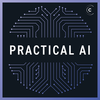Mozart to Megadeath at CHRP
Daniel and Chris groove with Jeff Smith, Founder and CEO at CHRP.ai. Jeff describes how CHRP anonymously analyzes emotional wellness data, derived from employees’ music preferences, giving HR leaders actionable insights to improve productivity, retention, and overall morale. By monitoring key trends and identifying shifts in emotional health across teams, CHRP.ai enables proactive decisions to ensure employees feel supported and engaged.

